|
|
 |
 |
 |
|
|
|
AMPTHILL
|
|
|
|
|
|
|
|
History
|
|
.
|
.
|
|
AMPTHILL is rightly famed for its Georgian character, but the true
source of its charm lies deeper than this, for a Georgian front often conceals an earlier interior, and even the Victorians have made their contribution. Nowhere
is this better illustrated than in the Town Clock 20th Century electric in a late 18th century concept surmounted by an early 18th century cupola on a 19th
century building.
THE MARKET
was for centuries crucial to the life of the town, bringing trade from the surrounding villages and generally supporting the local economy. Ampthill market has been held on a Thursday since 1219 and was confirmed by royal charter when the first of a number of annual fairs was authorised. The markets and fairs were for cattle as well as goods, and spilled along the main roads, particularly Dunstable Street, which was known as Cowfair End for a time.
In the mid-1780s, Lord Upper Ossory of Ampthill Park led a campaign to improve the town centre (and increase income from
the market) by creating a Market Square in front of a new Market House (now Richardson's), and tidying up the butchers' shambles, which ran from the Market House
and into the Oxlet.
|
.
.
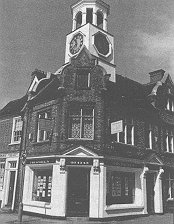
Ampthill Town clock
|
|
.
|
|
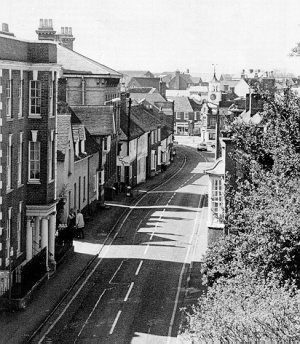
Church Street, Ampthill
|
(The butchers had been particularly unpopular in the 15th
century when they were always throwing rotting offal into the town pond, the Oxflood).
A new well was sunk on the Market
Square and a pump installed encased in a stone obelisk (the gift of Lord Ossory) and surmounted by an oil lamp. The town clock, formerly on the old market house,
was set in a new turret surmounted by a cupola, and placed on the 15th century Moot HallL where the manor court met. The Moot Hall (similar to that at Elstow) was
pulled down in 1852, and the town clock moved to present Clock House, which replaced it.
From the Market Square two
of the town's former coaching inns can be see: the White Hart, a front of about 1730 on a very much older building once known as the Red Hart, remains in business.
The King's Arms, formerly the Crown, now 9 Church Street, has an 18th century front, but is similarly much older; it closed in the 1950s when the ground floor
was converted into shops.
In the Kings Arms Yard are ancient buildings used in the 17th century to house needy
people at the expense of the parish. It is thought that the roundel of pargetting with crown, fleur-de-lis, the dated 1677 and initials W.H commemorates this
use the initials standing for Work House.
|
|
The path leads on to the newer parts of the town passing The Hop
Ground, formerly belonging to the White Hart, but now after a century and more of neglect a remarkable garden created from 1967 by William Nourish, and since his
death maintained for the Town Council by a group of volunteers. The garden is open to the public from time to time.
CHURCH STREET, leading off from the Market Square in the direction of Maulden
contains many interesting buildings most notably Avenue House (number 20) formerly the home of Professor Sir Albert Richardson, KCVO, one-time President of the
Royal Academy, whose love for the Georgian period is legendary and was reflected in his work as an architect. 'The Professor' died in 1964, and plaque on the wall
of his former home carried a tribute from his old friend John Betjeman, 'He strove to preserve the best in English landscape and buildings ………..' The house
was built for John Morris, a brewer, to the design, it is thought, of John Wing the Bedford architect, in 1790, the easternmost section having been added in 1819.
The house takes its name from a lime walk in the garden.
On the opposite side of the road is the Ampthill Masonic
Centre built in the early 1860s as a Court House, the architect being Sir John Taylor, KCB. In 1961 James Hanratty was brought before the magistrates here accused
of the murder of Michael Gregson in a lay-by off the A6 at Clophill, a crime for which he was ultimately hanged in the last judicial hanging in this country. The
courts moved to new premises in Woburn Street in 1963.
Next door, now divided into four, as a fine Jacobean House
once the home of Edmund Wingate (1596-1656) mathematician and legal writer and reputedly the inventor of the slide rule. For a time he had lived in Paris where he
taught Henrietta Maria, wife of Charles I, to speak the English language; but his later sympathies were very much with the parliamentary cause. A later owner and
resident was George Wateson, born in Ampthill and for a time Rector of Millbrook. But he was deprived of the Living for refusing to take the oath of allegiance to
William and Mary on the grounds that to do this would break the oath he had already taken to James II. (There were over 400 good and saintly clergy who were
similarly deprived for conscience's sake at that time: they are known as Nonjurors).
On the opposite side of
the road is Gates House (number 28) built in about 1807 and distinguished by a fine wrought iron screen and entrance gates thought to have been those made for
Park House by the local blacksmith Jasper Grimes and designed by John Lumley, in the early 1700s.
At the brow f the
hill is THE Wingfield Club, opened as a United Services Club by the Princess Beatrice in 1921. The house, built in 1742 by Catherine Coppin, was for a time the
home of the Revd Charles Cavendish Bentinck, one-time Rector of Ridgmont, and his wife Sinetta. For some years they had rented the house now 41 Church Street,
but moved here in 1848. Two years later Mrs Bentinck died, and shortly her husband married again, the eldest daughter of that marriage eventually becoming
Countess of Strathmore, mother of Queen Elizabeth the Queen Mother.
Modern housing developments to the east and south of
Church Street occupy what was formerly the estate of Sir Anthony Wingfield (1857-1952). Ampthill House, which stood where the eastern section of Brinsmade Road is
now, had been built in 1829, but was considerably enlarged by Mr Wingfield (as he was then) to provide accommodation for the large number of visitors he
entertained. His private zoo was a great attraction, stately Edwardian ladies and distinguished gentlemen (9ncoluding minor and foreign royalty_ were pleased
to be photographed on the most unlikely mounts, while camels, bison, pigs, ostriches and llamas roamed the estate freely, and were made to work where
possible. Many of the animals were transferred to Whipsnade when that zoo opened, and all had long gone when following Sir Anthony's death, the house was pulled
down and its parkland built upon.
The Cloisters is a more recent development on the Ampthill House estate and marks the
site of a modest 17th century mansion reputedly built for Ampthill's most famous son, Richard Nicolls (although documentary evidence for this legend has not – as
yet – been found). Nicolls was born in 1625 at Great Lodge in Ampthill Park where his father was a keeper, and early in life entered the royal service. He
followed the royal family into exile on the continent after the execution of Charles I and became a friend of his son, James Duke of York (afterwards James II).
After the restoration Richard Nicolls was sent as senior of three commissioners with a small supporting force, to recover the North American territories from the
Dutch. In 1664 he received the surrender of Nieuw Amsterdam which he renamed New York, after the Duke of York, and here he remained for a while as Governor. Having
retired to Ampthill, he was called to attend James, then Lord High Admiral, at the battle of Sole Bay (Southwold) in 1672. Mortally wounded by a Dutch cannon ball,
his body was brought back to Ampthill for burial, the fatal cannon ball being incorporated into his memorial in the parish church.
|
|
.
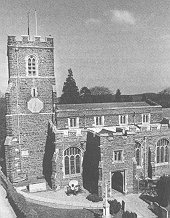
Ampthill Parish Church
.
|
THE PARISH CHURCH, dedicated in honour of Saint Andrew, in its present form dates from 14th and
15th centuries with 19th and 20th century additions; but there was a church on the same site in Norman times, and perhaps earlier. A comprehensive guide book is
available at the church.
CHURCH SQUARE
has on its east side Brandreth House, now two, built for Thomas
Gibbs in about 1810. He was a noted seedsman to the Board of Agriculture for whom we did much experimental work on grasses, and married Sarah Brandreth of Houghton
Regis, hence the house's name. Adjoining are the Feoffee Almshouses, maintained still by feoffees (trustees) using the income from charitable endowments made by
townsfolk in earlier centuries. The almshouses were established before 1485, and those on the left of the gateway may be of even earlier date; but the houses which
border the churchyard and the one to the right of the gateway were built in the 19th century.
|
|
On the west side of Church Square the imposing three-storey Dynevor
House has the initials S.V and the date 1725 on the rainwater heads. S.V. was Sir Simon Urlin, Recorder of the City of London from 1742 to 1746, who had the house
refronted and remodelled at that time.
|
|
.
|
.
|
.
|
.
|
|
RECTORY LANE leads from west of the church tower by footpath to either Houghton Conquest (following the churchyard boundary) or Bedford Road, which is reached by the Holly Walk, a path made in the early 1820s as a short cut from the church to Park House.
A short way along the Maulden Road, on the north side, is Gas House Lane, a reminder that the town's gas works was built here
in 1849. This was formerly South Gate Walk, the principal approach to Houghton House, home of the Bruce family whose head was the Earl of Ailesbury.
|
.
.
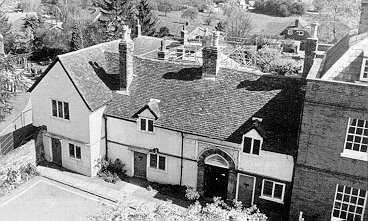 . .
Feoffee Almshouses, Amphill
|
|
Their 17th century walled garden and orchard can be seen ahead.
The large new housing estate leading off from the roundabout in the Maulden Road is reached by Ailesbury Road (on the side of
Cut Throat Lane!). The roads of this development bear the names of many worthy families from Ampthill's history.
|
|
.
|
.
|

|
.
|
|
BEDFORD STREETis
the most changed of all the town's four main roads, having been considerably restricted on its eastern side until the late 1930s by the buildings of Ampthill
Brewery which had been established by John Morris in the 1770s, flourished a century under family management, and retained the Morris name until its closure in
1926, when the business was taken over by J.W. Green of Luton. Ampthill Brewery was among the largest in the county and its loss was a significant one for the
town. Nothing remains of the buildings, except a vaulted store now a restaurant – and a few walls around the car park. The market was moved here from
Market Square in 1987.
The first building to be put up on the brewery site was a cinema, The Zonita, which opened in 1937
and closed in 1960 a brief but colourful existence. Converted into office buildings, the Zonita became a snooker hall in 1982, and later its ground floor was
made into small shops named Rose Walk.
Further up Bedford Street and now used as a garage, is the former National
|
.
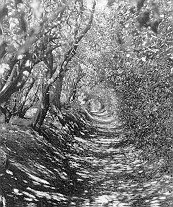
Holly Walk
|
|
School, one of the town's two main schools. Supported by
the parish church, this school opened in 1845 and closed 1954 when the local authority took responsibility for education in the town.
The Bedford Road continues to the top of the hill where it becomes Hazelwood Lane. Here, a sign points the way to Houghton House, a
magnificently sited Jacobean mansion built by Mary, Countess of Pembroke, in about 1615. Dismantled in 1794, the house has been a ruin for many years, but from
what remains and from old records and pictures it can be seen that this was a building of considerable distinction with impressive porticos at the north and west
fronts and corner towers surmounted by concave pinacles with gilded finials. From 1620 until 1738 it was the home of the Bruces, Earls of Ailesbury, prominent in
local life and at court where they held high office. The last Lord Ailesbury to live here was Thomas, a supporter and friend of James II and consequently under
constant suspicion following that monarch's departure in 1688. Eventually the situation became intolerable, and he was forced to retire to the continent where he
lived at Brussels until his death at the age of 85 in 1741.
Francis, Marquess of Tavistock, came to live here
shortly before his marriage to Lady Elizabeth Keppel, but in 1767 he was killed in a riding accident in Houghton Park, and within a year his widow had died too,
'of a broken heart'. The Duke of Bedford who had bought the estate in 1738, wished to farm the land but had difficulty in finding tenants for the house, and
so after a while it was dismantled.
.
|
|
.
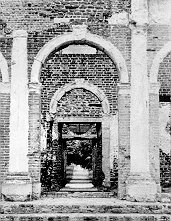
Houghton House
|
DUNSTABLE STREET, though victim of too much traffic, has some historic and
distinctive features. Number 105 was in the late 18th and early 19th centuries the home of the Royal School of Embroidering Females who, under the patronage of
Queen Charlotte, made many of the complex and lavish hangings used in the refurbishing of Windsor Castle in hand at that time. On the opposite side of the road The
Gazebo is all that remains of an extensive mid-18th century estate which stretched from the road the site of the Alameda where there was an artificial 'Canal' to
give focal point to the garden. The house, which belonged to this estate, stood at the edge of the footpath where numbers 84 and 86 now stand. In 1882 the canal
estate was developed, the house pulled down and replaced by two villas built adjoining their new chapel by the Methodist trustees.
The imposing Methodist Church was designed by Charles Bell of London and opened on 13th August 1884, replacing an earlier building in Woburn
Street. The Baptist Church further along the road, was built on a site acquired in 1822 and stood back from the pavement.
|
|
Extensions in 1870 brought the buildings forward by
creating a vestibule, and in 1893 accommodation was doubled by the erection of an adjoining Sunday School room and vestry.
The Primitive Methodists opened a chapel in Saunder's Piece in 1871; after a spell as 'The Kinema', it was from 1949 to 1994 a branch of the
County Library. Empty for a couple of years it is now the home of S. Luke's Church, part of the newly formed Traditional Anglican Church.
The Strict Baptists built a new chapel in Oliver Street in 1904; it was designed by the Ampthill architect Alfred Wildman, and opened on 11th October that year.
AMPTHILL HALL began existence as a barn belonging to Christopher Bennell where the Quakers started holding meetings in 1726. Rebuilt from the old materials on the same site in 1753, it was extended to its present size in 1768, and continued in use as a meeting house until the early 1900s. For many years it served as Saint Andrew's Church hall, but was purchased by the Council in the 1970s for conversion to public use. The front section of the hall is a 19th century addition. Quaker meetings were resumed here in 1990.
A sign on the dentist's wall at the top of Oliver Street points 'To the Foundry'. This was the Sand Road Iron Works (Oliver
Street then being called Sand Road) built in the early 1870s by William Whitehouse on the corner of this road with Neotsbury Road (formerly Foundry Lane). The
foundry made chiefly agricultural equipment and domestic ironwork, notably railings. Alfred Hetley, Mr Whitehouse's successor, continued the business until the
early 1920s. After military use in the war the buildings were occupied by Jewsons, but demolished in the 1970s when the present houses were built.
The Mid Bedfordshire District Council's Offices in Dunstable Street were built for the Ampthill Rural District Council to designs by
Sir Albert Richardson and opened in 1967. Subsequently, the offices have been modified and considerably extended.
THE CEDARS was built as the Union Workhouse in 1836, the architect being James Clephane, whose other work includes Wrest Park House. The workhouse was built to accommodate 469 inmates from Ampthill and the surrounding parishes, which formed the Union, and operated under a regime of the strictest discipline and segregation. Consequently there was a great dread of 'going to the Union' which was only slightly alleviated by new legislation of 1929 which made this the Public Assistance Institution. But all that became history when, in the late 1940s, the building re-named The Cedars began valuable community service as a Local Authority old people's home, closed in the early 1990s. At the time of writing (1997) plans are in hand to convert it into luxury apartments.
The former Board Room, built for the Poor Law Guardians in 1902, is now the town's library. Particularly noteworthy is its modern weather vane commemorating the Gold Hare (Masquerade) treasure hunt – a story worth investigating in the library.
|
|
Station Road once led to Ampthill Station, but the latter
(opened in 1868) was closed in 1959 and its site, cut off from Station Road by the bypass is now a part of the industrial estate. It is interesting that the World
Speed Record was held from 1897 to 1903 by a Midland Railway train sustaining a speed of 90 m.p.h over 2.36 miles of track here. Close by the station, once very
isolated amongst the trees of Little Park, is the Ampthill Hopspital, as it was originally known.
These almshouses, built in
1701 under the directions of the will of John Cross of Oxford, were to accommodate old college servants. In more recent years a wider range of resident has been
accommodated, and the flats are now administered by Church Army Housing.
There are two Schools in Station Road, The Firs,
and Alameda, built in the early 1970s as a primary and middle school respectively. Redbourne School, on the extreme boundary of the town at Running Waters, opened
as the Ampthill/Flitwick Secondary Modern School in 1954.
|
.
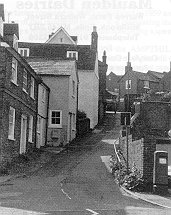
Brewery Lane
|
|
It takes its name from the ancient administrative area of the shire,
which included both Ampthill and Flitwick, the Hundred of Redbornestoke.
WOBURN STREET was once known as Mill Street, the local rope makers having a horse-powered mill here at one time. Beneath the great, empty wrought-iron sign bracket (numbers 1 &3), is another of the town's coaching inns, formerly the Kings Head, previously the Swan, refronted in about 1734 and since 1948 used as offices.
Behind number 6 was a workhouse, built in 1729 and in operation until 1795. John Wills, who was in charge in 1772, was
allowed £230 a year out of the rates for bedding, clothing and food for the inmates – quite a sum. A successor workhouse, the House of Industry, was built in
1811 on Park Hill (where the wooden houses stand0 and was the scene of serious rioting in May, 1835, when new poor law regulations were brought into force. The
rioting, which had started in Lidlington and Millbrook when payments previously made were withheld, moved to the Market Square and continued until police were
brought from London (no Bedfordshire force in those days) and the militia called out and held in readiness at Luton.
By
the late 18th century the upper parts of Woburn Street were known as Slutts End. Even so, the Methodists were happy to build a chapel behind what is now number 29,
in 1813. It was an imposing building with an interior compared by one who knew it to the hatchway of a ship. 470 worshippers could be accommodated in an incredibly
restricted building.
Opposite the old chapel, which was pulled down soon after its congregation moved to their new
building in Dunstable Street in 1884, is Claridge's Lane, formerly Rope Walk (doubtless where the horse mill was), and named after George Claridge, a grocer whose
shop and house was on the corner of Dunstable Street and Woburn Street.
So on to the thatched Ossory Cottages, much
admired and photographed, which were built for his estate workers by Lord Ossory in the early 19th century and bear his plaque and the date. The other cottages in
this group are older, and all have been extensively restored and modernised. Across the road are The Sands, once an open space as its name suggest, and the
playground of the school which was consequently unofficially known as the Sands School. Built as the British School and opened for children associated with the
town's chapels in 1844, it became the Wesleyan School in the 1890s and after 1954, Ampthill county Primary (subsequently, in new premises, Russell School). The
building is now a restaurant.
|
|
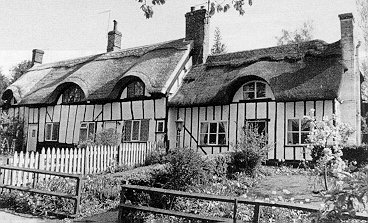
Alameda Cottages
|

|

|

|
|
THE ALAMEDA, planted for the benefit of the town by Lord and Lady Holland, was created between 1821 and 1827 in imitation of the 'almeidas' the Hollands had admired in their travels to Spain and Portugal. Its splendid gates, set in a red brick curtain wall, were removed and the wall demolished, by the Duke of Bedford's workmen in 1882. (Later the gates were given by the Duke to Bedford School, where they form the St Peter's Green entrance). The present gateway was constructed to Professor Richardson's design, in 1921, when Princess Beatrice came to unveil the War Memorial which was built at the far end of the Alameda. This memorial, the Cenotaph, was planned in association with q United Service Men's Club in Church Street, and many thought this inappropriate. So a second memorial was arranged, and unveiled in the churchyard a week after the Cenotaph, by Lord Ampthill. Both memorials were designed by Professor Richardson.
.
|
|
.
|
.
|
.
|
|
The Alameda leads to The Firs (sometimes known as
Cooper's Hill). This was from the 1820s a pine plantation of great beauty and much frequented by local people. In 1917 the trees were cut down for use as props in
the trenches in France. The Firs remained a scarred wasteland until the heather took over, a reversion to its former state when this areas was known as Ling
(heather) Hills.
Woburn Street ends with Agate House, the Bedfordshire Cheshire Home built in the late 1970s. In
this part of the town most of the sporting interests have their base – cricket, tennis, netball, football, angling and the children's recreation area in the
park;
|
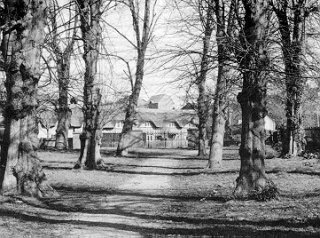
The Alameda
|
|
rugby in Dillingham Park and more football in the adjoining Lawrence
Park. All these, with the sports hall behind Parkside Hall and adjoining Nottingham Rooms, make this very much a social centre for the town, as most of these clubs
and activities have provided themselves with up-to-date facilities and accommodation and are professionally served and organised by their management committees. .
|
|
.
|
.
|
.
|
|
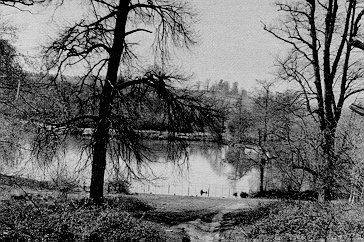
Ampthill Park, Reservoir
|
AMPTHILL PARK, more accurately Great Park, was formed when Sir John Cornwall purchased the manor of Ampthill from the St Amand family early in the 15th century. Already famous for his skill in the tournaments, he achieved additional renown in the French wars, notably at Agincourt (1415) where he was a commander in the English army. His wife was Henry IV's sister, the Princess Elizabeth of Lancaster, and thus he became uncle to Henry V.
Here at Ampthill, the park enclosed, he began building a house appropriate to his status. (Perhaps he planted some of the
oaks, many
|
|
of which survived almost into our time, although too old
for ship building in the 17th century). Ampthill Castle, 'stately on a hill with four or five fair towers of stone' occupied a considerable site between the Woburn
Road and the top of the hill where Lord Ossory was to put the Katherine Cross centuries later. No contemporary picture of it has yet been found, and some sketchy
plans are hard to interpret. But the descriptions of those who saw it tell of an inner and outer court with high walls punctuated by 'fair towers' or turrets.
There was no keep, but accommodation was built against the walls, the principal buildings such as the great drawing room and the chapel, being on the hill.
(Westminster Pond was doubtless a part of the castle complex, a valuable source for the supply of fresh fish).
Cornwall
died in 1443 and was buried at Blackfriars in London; his wife had died some years earlier. Their only son having been killed in the French wars, the estate
passed after protracted dispute with Cornwall's illegitimate sons to Lord Edmund Grey of Wrest, who paid 6,500 marks (£4,300) for it in 1454. Lord
Edmund's grandson, a gambler and wastrel, forfeited the estate to Henry VII when unable to repay a debt, and Ampthill came into royal ownership. It was Henry VIII
who, by making Ampthill a favourite base, brought prosperity and prominence to the town.
The court came down at
least once a year, usually in autumn as part of a progress from Windsor to Grafton in Northamptonshire, and although affairs of state received their due
attention, the king's chief pastime was hunting. Deer, bred in Little Park (hence its name) ensured his needs were well met, and additional hounds – the king's
usually came with him – were held in readiness too. The ladies of the court and the less agile gentlemen watched the hunt from a construction known as 'The
Stand' ready to take pot shots at the unfortunate deer who would be driven in their direction by the foot hunters and hounds.
KATHERINE OF ARAGON, married to Henry for almost 20 years before he began to take steps
to end their relationship, was particularly fond of Ampthill, although her confinement here while Cranmer's court at Dunstable Priory decided her fate could not
have been a pleasant. The court announced the invalidity of the marriage on 23rd May 1533; she refused to meet the deputation sent to inform her until 3rd July,
and then, surrounded by her household and friends, and with great dignity, made her defiant stand that she was the king's true wife.
After Henry's death the castle was neglected, his immediate successors no doubt having no liking for a place with such unhappy associations,
and by Queen Elizabeth's time it was becoming ruinous and quite uninhabitable. Royal visitors of that period (and later, like James I who had plans to rebuild the
castle) stayed at Great Lodge, the steward's house on the site of the present Park House.
In the 1680s much
building work was done at Great Lodge for Diana, Dowger Countess of Ailesbury, who had moved there from Houghton House. After her death John, Lord Ashburnham,
whose father had received the park from Charles II in repayment of a loan, planned to extend the house and make it his principal home. For a time Nicholas
Hawksmoor was his architect, but his plans were considered too drastic, and first John Lumley of Northampton and then William Winde, were brought in to meet the
earl's exacting requirements. But he died before the work was finished and park and house passed eventually into the possession of John, 2nd Earl of Upper Ossory
who in the 1770s began a complete reconstruction and enlargement of the house, for which he engaged the architect Sir William Chambers. At the same time he
employed Lancelot 'Capability' Brown to landscape the park.
The principal front which for Great Lodge and Lord
Ashburnham's house had been facing south, was made to face north, the remains of Great Lodge being on that side of the building were swept away, and an imposing
main entrance with an impressive flight of steps up to the door at first floor level took its place. New wings were constructed, and the whole building lengthened.
In the park 'Capability' enhanced existing features by planting trees in isolated clumps and merged the park boundaries
into the surrounding landscape with narrow plantations. A new drive was constructed to give a more interesting approach to the house. The old entrance had been at
the lodge in Woburn Road (now called Hollyhock Cottage) through the park past Russett Lodge (given a classic temple appearance by Lord Ossory) and so through what
is now the Darkenings to the sunken lime walk, the Green Walk planted way back in Lady Ailesbury's time and cut down in 1968.
The new approach began further along the Woburn Road (where the entrance to the car park is now) at a new lodge (demolished 1972) and passed
the remaining fragments of the castle and the new Katherine Cross, set in a grove of Scotch pines, down the hill, with glimpses of water from 'Capability's' new
lake ("The Rezzy") between the trees on the right, and so to Park House, beyond which the drive, with more glimpses of water from a lake on the north
(drained 1850) joined the Bedford Road at the foot of Hazelwood Lane Hill.
When Lord Ossory died in 1818 the estate
passed to his nephew, Lord Holland, whose widow sold it to the Duke of Bedford in 1841. Just over a century later the northern part of the park, including Park
House, was sold to Bovril Ltd, whose factory had been evacuated to Reddings Wood in the war, and in 1947 the remainder of the park was sold to Ampthill Urban
District Council for little under £11,000.
(A companion to the Katherine Cross was erected by the Duke of Bedford
to commemorate the training camp he built (and financed) on this site in World War I. The memorial records the remarkable fact that 10,604 men were brought here,
of whom 707 were killed in action. Some of the bronze plates bearing the names of the latter were stolen in 1970.
Cooper's Hill – known locally as The Firs – is one of the few remaining examples of the heaths, which one stretched across Bedfordshire
along the Greensand Ridge. A lowland heath of National importance, it has been designated a Site of Special Scientific Interest (SSSI) by English Nature and was
declared a Local Nature Reserve in 1980 by Bedfordshire County Council. Owned by Ampthill Town Council, the heathland is managed by the Wildlife Trust.
A beautiful area highly coloured when the heather is in bloom, is heath is also very delicate and should be treated with great respect.
|
|
Back to Top
|
LOCAL INFORMATION
|
|
Play Groups
|
|

|
Redborne Day Nursery,
Flitwick Road
Jack and Jill,
The Health Centre,
Oliver Street
Lady Bird,
Methodist Church,
Chandos Road
.
|

|
|

|
Pre-school Playgroup Association,
40 Church Street,
|
(Secretary Ms Tamsyn Kramer)
|
|
|
|
|
|
Back to Top
|

|
|
|
|
|
|
Schools and Colleges
|
|

|
Firs Lower School,
Station Road,
Russell Lower School,
Queens Road,
Alameda Middle School,
Station Road
Redborne Upper School and Community College,
Flitwick Road,
|
Tel: (01525) 402735
(Headteacher Mrs T Mostowfi)
Tel: (01525) 755664
(Headteacher Mrs J Bramwell)
Tel: (01525) 750900
(Headteacher Mr M L Meakin)
Tel: (01525) 404462
(Headteacher Mr Nigel Croft)
|
|
|
|
|
|
Recreation and Sports Clubs
|
|

|
Ampthill and District Rugby Club, Dillingham Park,
Woburn Street
Ampthill Town Football Club,
Ampthill Park,
Woburn Street
Ampthill Town Cricket Club,
Ampthill Park,
Woburn Street
Ampthill Athletic Football Club
Queensman Football Club,
Lawrence Park,
Woburn Street
Ampthill Town Boys Football Club,
Oliver Street
Ampthill Ladies Netball Club,
Nottingham Rooms,
Woburn Street
Ampthill Badminton Club,
Alameda Sports Hall,
Woburn Street
Ampthill Angling and Fish Preservation Society,
20 Arthur Street
Ampthill Carpet Bowls Club
|

|
|
|
|
|
|
Back to Top
|

|
|
|
|
|
|
Cultural and Leisure
|
|

|
Ampthill Allotment Association
Ampthill Festival Choir
Ampthill and Flitwick Dramatics Society
Army Cadet Force
Ampthill Detachment,
Drill Hall,
Woburn Street
Ampthill Town Band
Ampthill Bellringers,
St Andrews Church
Ampthill Bridge Club
Ampthill Cub and Scout Group,
The Scout Hut,
Station Road
Ampthill Sea Cadets,
Ampthill Park
Ampthill Guides and Brownies
Ampthill and District Preservation Society
|

|
|
|
|
|
|
Back to Top
|

|
|
|
|
|
|
Churches
|
|

|
St Andrews Church,
(Church of England),
Church Square,
Church Street
Methodist Church,
Dunstable Street
Baptist Chapel,
Dunstable Street
Roman Catholic Church,
Flitwick
St Lukes Church,
Saunders Piece
Society of Friends,
Ampthill Hall
|

|
|
|
|
|
|
Local Government
|
|

|
Ampthill Town Council,
9 Church Street,
.
|
Tel: (01525) 404355
|
|

|
Mid Beds DC,
12 Dunstable Street,
.
|
Tel: (01525) 402051
|
|

|
Magistrates Court,
The Court House,
Woburn Street
Registrars Office,
The Court House,
Woburn Street
.
|

|
|

|
Mid Beds Housing Ass.,
Dunstable Street,
|
Tel: (01525) 404422
|
|
|
|
|
|
Police and Emergency Services
|
|

|
Ampthill Police Station,
Woburn Street,
Ampthill Fire Station
Ampthill Ambulance Station
|
Tel: (01525) 404422
|
|
|
|
|
|
Back to Top
|

|
|
|
|
|
|
Health and Welfare
|
|

|
Ampthill Social Centre,
Houghton Close
.
|

|
|

|
Ampthill Health Centre,
Oliver Street,
.
|
Tel: (01525) 402302
|
|

|
Cheshire Homes,
Agate House,
Woburn Street
|

|
|
|
|
|
|
Local Events
|
|

|
Morris Dancing at Katherine's Cross
|
1st May
|
|

|
Ampthill Festival and Gala
|
Last two weeks of June
|
|

|
Music Festival
|
June
|
|

|
Flower Festival
|
June
|
|

|
Remembrance Day Parade & Service
|
November
|
|

|
Christmas Lights
|
November/January
|
|

|
Carol Service
|
December
|
|

|
Kings Arms Path Gardens Open Days
|
Spring/Summer/Autumn
|
|
|

|

|
|
|
|
|
